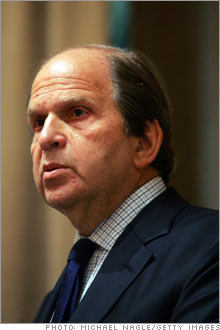Lazard goes under the microscopeA new book is about to expose some dirty secrets about the international investment bank, and has Wall Street drooling with anticipation. Fortune's Adam Lashinsky takes a peek inside the firm.(Fortune Magazine) -- The international investment bank Lazard has always been synonymous with grand ambition. Long a high-touch shop where rainmakers like Felix Rohatyn and Steven Rattner cast far bigger shadows than the size of their firm seemed to justify, Lazard today is a publicly traded company with a hot stock (it has doubled since its May 2005 IPO), a bigfoot CEO in Bruce Wasserstein and a healthy stake in the white-hot M&A market. Even the firm's biggest goof of late - Wasserstein's role in activist Carl Icahn's quixotic effort to take over Time Warner (Charts), parent of Fortune's publisher and CNNMoney.com - is looking bright. Lazard pocketed $5 million for advising Icahn and a cut of some $3.4 million more as Icahn has taken profits on his stake.
What's more, Wasserstein's embrace of Icahn doesn't seem to have hurt the firm's standing with corporate clients. Lazard (Charts) is advising utility TXU (Charts) and retailer Dollar General (Charts) in their multibillion-dollar sales to buyout icon KKR. Now Lazard is about to be treated to another dose of outsized attention: It is the subject of a new meticulously researched and titillatingly provocative book that chronicles the firm's illustrious ups and downs. The 712-page tome, The Last Tycoons, is already the talk of Wall Street, though it won't be released until April 3. (In mid-March it hit No. 65 on Amazon.com's bestseller list; the only higher-ranked unreleased book was the next Harry Potter installment.) The book, by ex-Lazard banker William D. Cohan, is packed with juicy tidbits and allegations about Rohatyn's affairs (a former girlfriend says he had a dalliance with Jackie O), Rattner's spats with fellow vacation-home owners in Martha's Vineyard (he persuaded client Brian Roberts of Comcast to buy out an objectionable neighbor) and the firm's dysfunctional inner workings. Curiosity about Lazard abounds, in large part because the firm's DNA is sprinkled around the Street (see box). Rattner, for example, is now managing principal at Quadrangle Group, which he formed when he left Lazard in 2000. He also occasionally picks up fees advising old Lazard client Comcast (Charts), and he's currently advising the New York Times Co., which is fighting with a portfolio manager at Morgan Stanley. (Times CEO and Rattner pal Arthur Sulzberger recently yanked his family's assets from Morgan Stanley.) Other prominent ex-Lazardians include Tim Collins, who founded buyout shop Ripplewood; Gerald Rosenfeld, who helms the North American branch of Rothschild; and Michael Price, the telecom powerhouse at Evercore Partners. (Rattner and Rohatyn, each of whom spoke extensively with Cohan, declined comment for this article.) The late '90s were a tough time for Lazard; its failure to scale up its business left it a pipsqueak compared with behemoths like Goldman, Morgan Stanley and Merrill Lynch. Now the old firm appears to be back in form. Revenues were up 16 percent last year to $1.6 billion, and if the M&A market dries up, Lazard will be able to count on its bankruptcy advisory business. Wasserstein, who did not cooperate for the book, declined to comment to Fortune. As for author Cohan - who left Lazard on good terms in 1995 and later worked at Merrill Lynch and J.P. Morgan Chase - he's on to his next project. Doubleday has agreed to buy his biography of David Wittig, the former Fortune cover boy (Nov. 24, 1986) and ex-CEO of the Kansas utility Westar, whose conviction on charges including wire fraud and money laundering was recently overturned. It remains to be seen if Wittig can rebound the way Lazard has. _____________ From the April 2, 2007 issue
|
Sponsors
|

